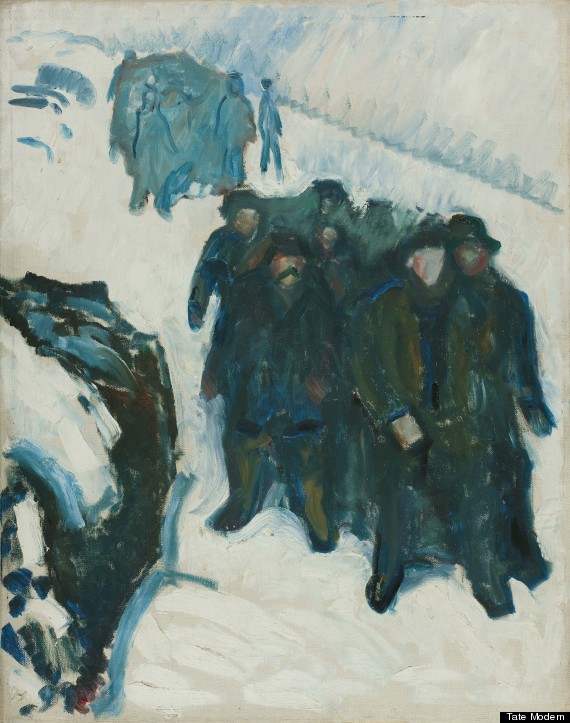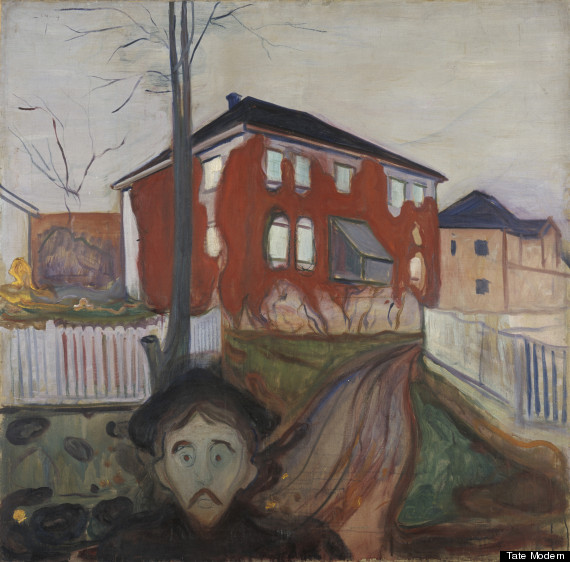Most of us know Norwegian painter Edvard Munch by his "Scream," which has continued to echo throughout our collective nightmares since the late 19th century. There are 11 iterations of the work, one of which recently sold for $120,000,000 at auction--none are featured in this exhibition, however.
"The Modern Eye," showing at the Tate Modern, shows Munch's later work from the 20th century. While we do not get to see the bloodcurdling agony of the night sky, we get more then our fair share of Munch-esque melancholy as seen through damp bedrooms, faceless murderers, vampires and wild manes of red hair.

Munch was born in 1863 in Lioten, Norway. His mother died when Munch was five and his sister soon after, leaving young Edvard and his siblings to be raised by their devout father, Christian. Their father would read Edgar Allen Poe stories before bed, while also using their mother's ghost to threaten them against misbehaving. The children were taught to fear their mother's ghost -- always hovering, watching. From this mix of ghost stories, religion and illness, Munch's vision was clouded by death, insanity and consumption from an early age. After a few failed affairs with women, sex became another symbol to be represented and feared, nearly as much as the others.
This bleak vision of life permeates Munch's oeuvre like a cold sweat. His works do not just paint disturbing images convincingly, they are clearly painted by one who is disturbed, physically and mentally. Scenes idyllic in subject matter gain an indescribable sense of lurking danger, as in "The Girls on the Bridge." In a scene Munch painted over and over, four women gaze out into the water, their backs facing the viewer. Munch seems very aware of the spectator's place in the work, approaching these oblivious women at what feels like a rapid pace. If the spectator only made it a few steps further, their shadow would appear in the water's reflection.

Most other works are far more blatant in their horror. "Red Virginia Creeper" features a ghoulish face, eyes agape, moving quickly toward the picture's edge. Pale as a corpse, the man's blank face makes it difficult to decipher if he is guilty or traumatized as he flees the quiet neighborhood behind him. The house oozes a mysterious red, the color of brick but the consistency of gushing blood.
Yet no image is as frightening as Munch's depiction of himself. While in his photographic self-portrait we see an arguably handsome man, his depiction of himself looks far more like Hannibal Lecter. A cartoonish blankness gives the sense of mental absence as Munch stares straight in your direction, seeing through you into the abyss.
The exhibition's title "The Modern Eye" asks us to consider the ways in which Munch ushered art from the age of Realism and Impressionism into Otto Dix-style Expressionism. His images have a frantic speed to them that recalls early cinema and photography through a raised awareness of the spectator. His serial imagery has garnered comparison to Walter Benjamin's "The Work of Art in the Age of Mechanical Reproduction," seen as working to blur the distinction between original and copy. Yet the visceral power of the works overshadows their imprints in Western art's evolution. While Munch's aesthetic style did age, his tone did not. It is not the technique of the paintings that make him one of the most famous painters of all time but their uncanny ability to scream.
"The Modern Eye" will show from June 28 to October 14 at the Tate Modern in London.

